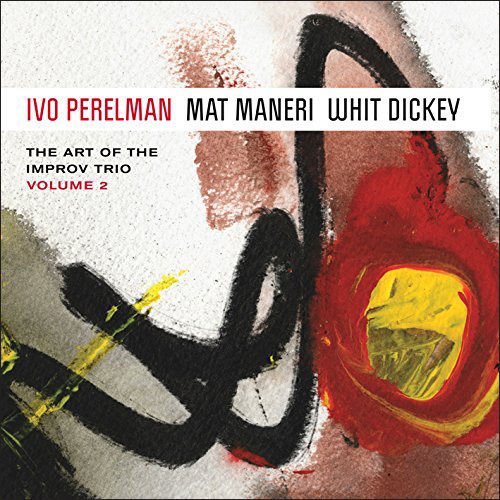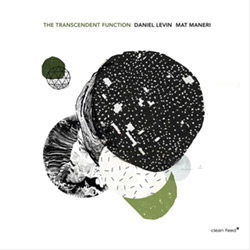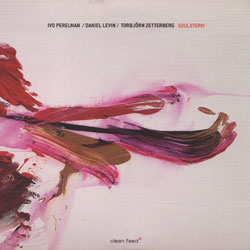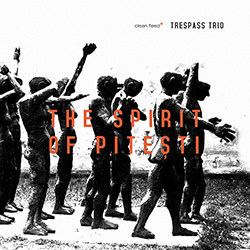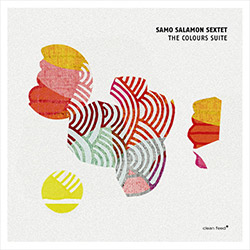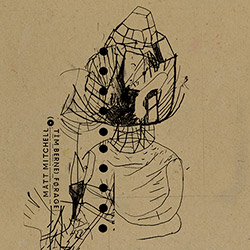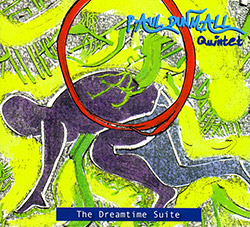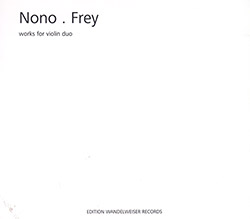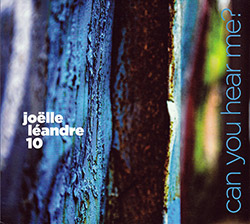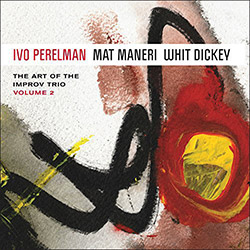
The second volume of New York/Brazilian saxophonist Ivo Perelman's 6-part series "The Art of the Improv Trio" is the most unique of the set, with Mat Maneri on viola and Whit Dickey on drums for a series of thirteen shorter and more intricate works of great range and diversity.
Save $1.50
Out of Stock
Quantity in Basket: None
Log In to use our Wish List
Shipping Weight: 4.00 units
Sample The Album:
Ivo Perelman-tenor saxophone
Mat Maneri-viola
Whit Dickey-drums
Click an artist name above to see in-stock items for that artist.
UPC: 5024792077229
Label: Leo Records
Catalog ID: LEOR772.2
Squidco Product Code: 23310
Format: CD
Condition: New
Released: 2016
Country: UK
Packaging: Jewel Case
Recorded Parkwest Studios, in Brooklyn, New York, in August, 2015, by Jim Clouse.
"Matt Maneri: "Ivo and I met much later: smooth, confidant and excellent. But Original! Where do these people come from? What is Ivo? He is a committed musician of the highest caliber, ready to go off the rails, crash the car, and explode my expectations. He is a master who does what he does, will do what he can and finalize the infinite. This CD, as every CD in this series, is accompanied by the brilliant notes by Neil Tesset, as well as Matt Maneri."-Leo
"This is only album in the series not to feature Gerald Cleaver: instead we have Whit Dickey on drums, joining Mat Maneri, viola. As with all the trios, these are musicians with whom Perelman is familiar, from a pool on which he's drawn during his creative surge of the last five years.
Previous sessions featuring Perelman and Maneri have generated an intricate and lucidly woven fabric - complimentary contours always expanding. On this occasion, the tendency is in the other direction, considering what can be done on a more elemental level by focusing on how it's put together - its interior nature - in a collection of relatively brief studies. The basic material is parsed, dissected and rearranged, internal relations reconfigured, and the new segments linked then separated afresh, all marked by fleeting changes in register, intonation and phrasing. It seems as if there's continual variation, yet in each piece the building blocks remain the same, in music that forgoes linear progression. This process is not a formal but poetic, analysis - explorations akin to Gerard Manley Hopkins' "inscape" of things, lying out of normal sight and only revealed by taking a different approach. It's not a rigid template, however. To a certain extent the trio go where their instincts take them, part of the art of improv.
As always with Perelman, brevity and restrictions are no bar to variety. The thirteen pieces have a range of paces, each unfolding in a manner that suits the treatment adopted. There's no single way to go about this. Sometimes things are clear - more accurately, set in higher relief - other times they're more dispersed and ambiguous. Likewise with texture and tempo: the viola's serrated edge and the warm, occasionally sour saxophone, smeared and wavering tones; widely spaced notes and closely packed clusters, with oscillations generated by identical and adjacent pitches producing phantom notes; steady speeds and accelerating figures but also passages where shape rather than pulse govern direction. At one point, Perelman and Maneri indulge in a mutual chuckle. The melody instruments drift over the delicate lacework of Dickey's strokes, swirls and seething cymbals. Elsewhere, his brusque drumming incites further fragmentation. He's the usual steady pair of hands (and feet).
Of course, an interesting notion does not necessarily make for a good album (in fairness, the way I've expounded it may not be universally acknowledged). Perelman and his colleagues have mastered a complex and subtle expressive language - a group of sympathetic and mutually articulate musicians - who also recognise the need to inject fresh ideas and consider matters anew, to remain stimulated and avoid staleness, though I suspect such things are never discussed in detail as they have a remarkable intuitive consensus on how they approach each album. There's no reason to think that they will not continue to produce engaging music for the foreseeable future, though fully appreciating the depth and range of their work might take a little longer."-Colin Green, The Free Jazz Collective
http://www.freejazzblog.org/2016/12/the-art-of-improv-trio-1-of-3.htmlGet additional information at Free Jazz Blog
Artist Biographies
• Show Bio for Ivo Perelman "Born in 1961 in São Paulo, Brazil, Perelman was a classical guitar prodigy who tried his hand at many other instruments - including cello, clarinet, and trombone - before gravitating to the tenor saxophone. His initial heroes were the cool jazz saxophonists Stan Getz and Paul Desmond. But although these artists' romantic bent still shapes Perelman's voluptuous improvisations, it would be hard to find their direct influence in the fiery, galvanic, iconoclastic solos that have become his trademark. Moving to Boston in 1981, to attend Berklee College of Music, Perelman continued to focus on mainstream masters of the tenor sax, to the exclusion of such pioneering avant-gardists as Albert Ayler, Peter Brötzmann, and John Coltrane (all of whom would later be cited as precedents for Perelman's own work). He left Berklee after a year or so and moved to Los Angeles, where he studied with vibraphonist Charlie Shoemake, at whose monthly jam sessions Perelman discovered his penchant for post-structure improvisation: "I would go berserk, just playing my own thing," he has stated. Emboldened by this approach, Perelman began to research the free-jazz saxists who had come before him. In the early 90s he moved to New York, a far more inviting environment for free-jazz experimentation, where he lives to this day. His discography comprises more than 50 recordings, with a dozen of them appearing since 2010, when he entered a remarkable period of artistic growth - and "intense creative frenzy," in his words. Many of these trace his rewarding long-term relationships with such other new-jazz visionaries as pianist Matthew Shipp, bassists William Parker, guitarist Joe Morris, and drummer Gerald Cleaver. Critics have lauded Perelman's no-holds-barred saxophone style, calling him "one of the great colorists of the tenor sax" (Ed Hazell in the Boston Globe); "tremendously lyrical" (Gary Giddins); and "a leather-lunged monster with an expressive rasp, who can rage and spit in violence, yet still leave you feeling heartbroken" (The Wire). Since 2011, he has undertaken an immersive study in the natural trumpet, an instrument popular in the 17th century, before the invention of the valve system used in modern brass instruments; his goal is to achieve even greater control of the tenor saxophone's altissimo range (of which he is already the world's most accomplished practitioner). Perelman is also a prolific and noted visual artist, whose paintings and sketches have been displayed in numerous exhibitions while earning a place in collections around the world." ^ Hide Bio for Ivo Perelman • Show Bio for Mat Maneri "Mat Maneri was born in 1969, and started studying violin at age five. He studied privately with Julliard String Quartet founder Robert Koff, and with bass virutuoso Miroslav Vitous. Mat received a full scholarship as the principal violinist at Walnut Hill High School, but left school to pursue a professional career in music. By 1990, Mat founded the critically acclaimed Joe Maneri Quartet with Randy Peterson. Mat started releasing records as a leader in 1996, and has developed four working ensembles. Pianists Paul Bley, Cecil Taylor, Matthew Shipp, and Borah Bergman have called upon Matt to perform with them in such venues as the Montreal Jazz Festival, the Library of Congress, and concert stages across Europe. Mat also enjoys a strong relationship with bassists Ed Schuller, Mark Dresser, William Parker, Michael Formanek, Barre Phillips, and John Lockwood. Never to be boxed in, Mat has also worked with Joe Morris, John Medeski, Tim Berne, Cecil McBee, T.K. Ramakrishnan, Franz Kogelman, Roy Campbell, Spring Heel Jack, Draze Hoops, and appears on an Illy B Eats remix CD. Mat presently teaches privately and through the New School / NYC, and performs and records worldwide." ^ Hide Bio for Mat Maneri • Show Bio for Whit Dickey "Whit Dickey (born May 28, 1954, New York City) is a free jazz drummer. He has recorded albums as a bandleader, with David S. Ware, Matthew Shipp and others. Free jazz drummer Whit Dickey first stepped into the spotlight as a leader with the release of his Transonic album from Aum Fidelity in 1998. Two years later, Wobbly Rail issued his Big Top release. Previously, he was best known for his solid work with Matthew Shipp and David S. Ware, with whom Dickey split in 1996. Early the following year, the drummer began composing the works that would be included on Transonic. Dickey penned all but two songs, "Kinesis" and "Second Skin," on the collection, and he even had a hand in those with the help of his fellow musicians on the album. The original compositions give a nod to the influence of "Criss Cross" and "Off Minor" from the legendary Thelonious Monk. Dickey recorded the album with the aid of Rob Brown on flute and alto saxophone, and Chris Lightcap on bass. In 2001, Dickey recorded half a dozen of his compositions with Mat Maneri, Shipp, and Brown under the name Nommonsemble, and put out Life Cycle through Aum Fidelity. Whit Dickey made a name for himself as the former drummer of David S. Ware's famous quartet. Since then Dickey's musical contributions have gone well beyond his work as Ware's drummer. He is capable of tremendous power and yet has the ability for subtle gesture. Dickey is a composer as well as a drummer and his music has reached new heights in his recent small group work, with a coterie of great musicians including alto saxophonist Rob Brown. He has been performing with Matthew Shipp since 1991 and continues to play and record with Roy Campbell Jr., Mat Maneri, Chris Lightcap and many others. Since 2007 Dickey has been focussing on developing an integrative improvisational style while working with Shipp's Trio. Daniel Carter and Dickey recorded an album pianist Eri Yamamoto in 2008. The album Art of the Improvisor from The Matthew Shipp Trio received much critical acclaim and was listed as one of the year's best of 2011. Dickey has started a cooperative unit with Sabir Mateen & Michael Bisio, which is another example of post- Coltrane integral unity, and is call Blood Trio. Shipp, Bisio and Dickey have also been working with Ivo Perelman in various configurations." ^ Hide Bio for Whit Dickey
4/17/2024
Have a better biography or biography source? Please Contact Us so that we can update this biography.
4/17/2024
Have a better biography or biography source? Please Contact Us so that we can update this biography.
4/17/2024
Have a better biography or biography source? Please Contact Us so that we can update this biography.
Track Listing:
1. Part 1 3:48
2. Part 2 4:19
3. Part 3 5:10
4. Part 4 5:34
5. Part 5 4:57
6. Part 6 4:40
7. Part 7 0:56
8. Part 8 1:18
9. Part 9 4:35
10. Part 10 1:24
11. Part 11 4:54
12. Part 12 5:37
13. Part 13 3:00
Improvised Music
Jazz
Free Improvisation
NY Downtown & Metropolitan Jazz/Improv
Trio Recordings
Leo Records
Search for other titles on the label:
Leo Records.


